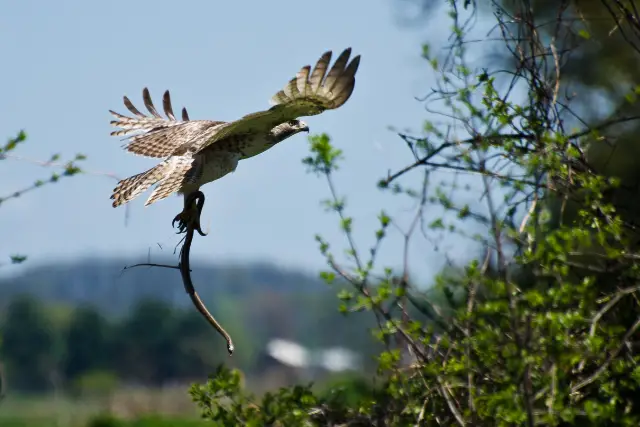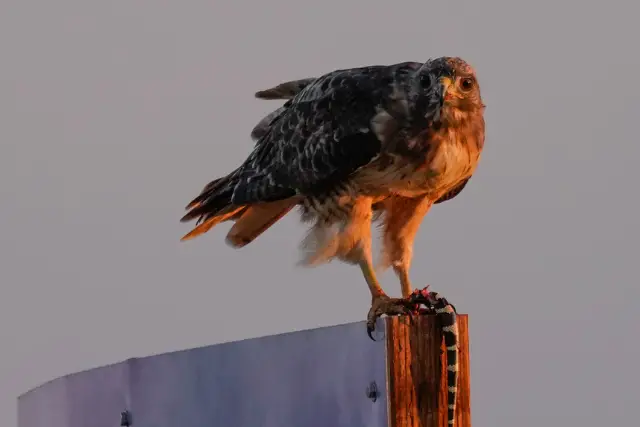Hawks are carnivorous birds that primarily feed on small mammals, birds, reptiles, and insects. But do hawks eat snakes? Well, this is one of the most highly debated questions worldwide, with some claiming that they do while others don’t agree.
Generally, the answer to this question will depend on its environment; after all, they do consume a wide range of prey. Plus, not every hawk species eat snakes. But several species have been known to eat snakes when they find them.
Do Hawks Eat Snakes?
Yes, hawks are known to prey on snakes. Hawks are raptors, which are birds of prey that have sharp talons and beaks specifically adapted for hunting and capturing other animals. While their diet primarily consists of small mammals and birds, they are also known to hunt snakes and eat them.
Hawks have excellent eyesight, which allows them to spot snakes from a distance.
Once they have located their prey, hawks will swoop down from the sky and use their sharp beaks and talons to grasp and kill the snake. They may also use their beak to deliver a quick and lethal bite to the head or neck.
It's worth noting that not all species of hawks will prey on a snake, as their diet can vary depending on their habitat and the availability of other food sources. However, there are specific hawk-snake species combinations like the Red-tailed Hawks snakes combination.
Hawk Species That Eat Snakes
Several hawk species are known to eat them. Here are a few examples:
- Red-tailed Hawk: Red-tailed Hawks are large, broad-winged hawks found throughout North America. Red-tailed hawks are opportunistic hunters and have been observed capturing and consuming snakes.
- Cooper's Hawk: Cooper's Hawks are medium-sized hawks known for their agility and speed. While they primarily feed on birds and small mammals, they have been documented preying on a venomous snakes as well.
- Harris's Hawk: Harris's Hawks are unique among raptors because they are highly social and often hunt in cooperative groups. These hawks eat a wide range of foods including small mammals, birds, reptiles, and even insects, including snakes.
- Roadside Hawk: The Roadside Hawk is a small to medium-sized hawk found in parts of Central and South America. It is known to feed on a variety of prey, including snakes.
- Short-tailed Hawk: Short-tailed Hawks are found in parts of the Americas, including the southeastern United States, Central America, and northern South America. While their diet primarily consists of birds and small mammals, they have been known to kill snakes as well.

Snake Species That Hawks Eat
Hawks are known to consume many snakes. However, the specific snakes they prey upon can vary depending on the hawk's geographic location and its own size and hunting habits. Some species that hawks commonly feed on include:
- Garter Snake: Garter snakes are a common food source for hawks. Garter snakes are relatively small to medium-sized snakes found in many regions.
- Black Rat Snakes: Rat snakes, also known as corn snakes or black snakes, are medium to large non-venomous snakes that hawks may prey upon.
- Rattlesnakes: Although hawks need to be cautious when hunting venomous snakes like rattlesnakes, they have been observed to eat rattlesnakes. When dealing with a poisonous snake, they usually target the snake's head.
- Bull Snakes. These snakes are relatively larger snakes, reaching lengths of 5 to 8 feet (1.5 to 2.4 meters).
- Gopher Snake: they’re indeed a species of snake that hawks may consume. Gopher Snakes are non-venomous snakes found in various regions of North America.
How Hawks Catch and Eat Venomous Snakes
Hawks employ several techniques to catch and eat snakes, utilizing their sharp talons and beaks without worrying about snake venom or snake bites. Here's a general overview of how hawks catch and consume snakes:
- Hunting: Hawks typically hunt from an elevated perch, such as a tree branch or utility pole, scanning the ground for potential prey. They have excellent eyesight, allowing them to spot snakes from a distance.
- Dive and capture: Once a hawk spots a snake, it may dive swiftly and silently toward its target. This maneuver is known as a stoop. Hawks can reach impressive speeds during their descent. They use their talons to grab and immobilize the snake.
- Subduing the snake: After capturing the snake, the hawk may use its sharp talons to hold the snake firmly, preventing it from escaping or retaliating. Some hawks may also use their beak to further control the snake's movements and prevent bites. Fortunately, some snakes die after being attacked.
- Transporting and consumption: Hawks often transport their prey to a safe feeding location, such as a tree branch or a secluded area. They may carry the snake in their talons while flying or hop along the ground if the snake is not too large. Once in a secure spot, the hawk will begin to consume the snake. They're known for eating snakes using their beak and swallowing them whole.
- Defense against poisonous snakes: When hunting venomous snakes, such as rattlesnakes, hawks like the red-tailed hawks need to be cautious. They often target the head to minimize the risk of being bitten. Additionally, hawks may have developed strategies to immobilize or disable poisonous creatures before consuming them.
Reasons Why Venomous Snake Can’t Constrict a Hawk
Generally, snakes never look up when looking for predators; therefore, they’re usually surprised when hawks grab them.
If it’s not killed while being attacked, then it’s carried mid-air where they’re helpless. After all, they do need the ground to constrict their muscles and mount an attack.
So when taken by surprise, they have little to no chance of winning a battle against a hawk.
Frequently Asked Questions
Do hawks consume large snakes?
They have been known to consume about 4 feet long snakes. In some rare cases, some huge hawks can attack an even bigger snake and carry it to a safer place and consume it.
Can hawks consume cobras?
Even though they can consume just about anything including small snakes. But they do stay away from certain snakes, like cobras. Unlike most snake species, cobras are highly poisonous creatures that can attain a maximum length of 6 feet.
Are venomous snakes dangerous to hawks?
Venomous snakes can be dangerous to hawks if they manage to bite the birds. However, it's worth noting that hawks have adaptations and behaviors that help minimize the risk of being bitten by snakes.
Conclusion
Hawks eat a wide range of animals, including snakes. Some bird species like the red-tailed hawk may prefer to eat rodents, but they never turn away from small to medium-sized snakes.
Fortunately, they don’t consume all snake species, and this includes some poisonous ones like King Snakes and cobras. But they have to be very careful when dealing with poisonous snakes, which can easily bite and kill them.

